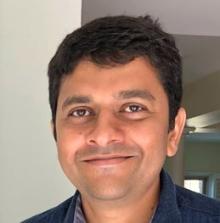
Neuroimmunology and Virology
Dr. Bhagavatheeshwaran earned his Bachelor of Technology in Biomedical Engineering from Cochin University of Science and Technology in India and his Master of Science in Biomedical Engineering from Drexel University in Philadelphia. He earned his Ph.D. in Biomedical Engineering and Medical Physics from Worcester Polytechnic Institute and University of Massachusetts where he studied and developed Magnetic Resonance Imaging techniques for imaging the retina with Drs. Timothy Q. Duong, Michalle Pardue, and Michael Kuhar.
During his postdoctoral fellowship with Drs. Xiaoping Hu and Michael Benatar at Emory University, he worked on developing specialized magnetic resonance imaging techniques and markers of disease progression in patients affected by amyotrophic lateral sclerosis (ALS). He joined the National Institutes of Health in 2011 as a Staff Scientist where he oversees the Quantitative MRI (qMRI) Core Facility. He has received the Dean’s Fellowship at Drexel University.
Research Interests
As an MRI physicist, Dr. Bhagavatheeshwaran‘s research focuses on techniques to improve the sensitivity and specificity of MRI in detecting changes in the neuronal microenvironment in neuroinflammatory diseases, which could help with understanding disease processes in-vivo. At present, his research focuses on developing quantitative MRI markers of disease progression in neuroinflammatory diseases such as multiple sclerosis, Human T-cell leukemia virus, type 1 or HTLV-1 associated myelopathy/tropical spastic paraparesis (HAM/TSP), Progressive multifocal leukoencephalopathy (PML), and neurocognitive impairments in HIV infection.
Quantitative MRI (qMRI) Core Facility
The primary goal of the Quantitative MRI (qMRI) Core facility is to provide investigators access to research MRI resources developed within and outside NINDS, and to assist in their implementation as endpoints in clinical trials of neurological diseases.
Scope of the Facility
The qMRI Core will primarily focus on groups that lack staff well trained in acquisition and processing of MRI data. The Core facility will help these groups implement the pulse sequences and provide the support needed to perform image analysis in well defined, time limited projects. A few examples of endpoints implemented at the core facility are shown below in Figure 1. The Core facility personnel are also available to work with investigators and their team to develop new markers.
In addition, the core will offer its services for postmortem MRI of the human brain and spinal cord, as well as for MRI-guided tissue slicing using a 3D printed cutting box if requested. There is a growing demand to image fixed human brain, especially entire autopsy specimens. The expertise necessary to acquire and interpret high resolution images from large brain specimens available in-house at the q-MRI Core will be provided to the broader NINDS and NIH community.
Lab Members
Current members:
- Brandon Bujak (2024-present)
- Caleb Atkins (2024-present)
- Kapish Putula (2024-present)
Former members:
- Jawad Aqeel (2020-21)
- Henry Dieckhaus (2020-22, winner of Outstanding Poster Award at NIH Postbac Poster Day 2021)
- Kendyl Bree (2021-23)
- William Andrew Mullins (2022-23)
- Roy Sun (2023-24)
- Krishna Josyula (2023-24, winner of Outstanding Poster Award at NIH Postbac Poster Day 2024)
Publications
Click here for a full list of publications
Selected Publications:
- Govind Nair, Roy Sun, Qing Xu, Kyra Hoskin, Kendyl Bree, Hellmut Merkle, Stephen Dodd, Alan Koretsky; A Method to Image Brain Tissue Frozen at Autopsy; NeuroImage (in press)
- Leon CD Smyth, Di Xu, Serhat V Okar, Taitea Dykstra, Justin Rustenhoven, Zachary Papadopoulos, Kesshni Bhasiin, Min Woo Kim, Antoine Drieu, Tornike Mamuladze, Susan Blackburn, Xingxing Gu, María I Gaitán, Govind Nair, Steffen E Storck, Siling Du, Michael A White, Peter Bayguinov, Igor Smirnov, Krikor Dikranian, Daniel S Reich, Jonathan Kipnis; Identification of direct connections between the dura and the brain; Nature 627, pages 165–173 (2024),
- Lee MH, Perl DP, Nair G, Li W, Maric D, Murray H, Dodd SJ, Koretsky AP, Watts JA, Cheung V, Masliah E, Horkayne-Szakaly I, Jones R, Stram MN, Moncur J, Hefti M, Folkerth RD, Nath A. Microvascular Injury in the Brains of Patients with COVID-19. N Engl J Med. 2021 Feb 4;384(5):481-483.
- Nair G, Dodd S, Ha SK, Koretsky AP, Reich DS. Ex vivo MR microscopy of a human brain with multiple sclerosis: Visualizing individual cells in tissue using intrinsic iron. Neuroimage. 2020 Dec;223:117285.
- Beck ES, Gai N, Filippini S, Nair G, Reich DS; Inversion Recovery Susceptibility Weighted Imaging with Enhanced T2-Weighting (IR-SWIET) at 3 Tesla Improves Visualization of Subpial Cortical Multiple Sclerosis Lesions. Invest Radiol. 2020;10.1097
- Azodi S, Nair G, Enose-Akahata Y, Charlip E, Vellucci A, Cortese ICM, Dwyer J, Billioux JB, Thomas C, Ohayon J, Reich DS, Jacobson S; Imaging Spinal Cord Atrophy in Progressive Myelopathies; Annals of Neurology 82(5):719-728.
- Absinta M, Ha SK, Nair G, Sati P, Luciano NJ, Palisoc M, Louveau A, Zaghloul KA, Pittaluga S, Kipnis J, Reich DS. Human and nonhuman primate meninges harbor lymphatic vessels that can be visualized noninvasively by MRI. Elife. 2017 Oct 3;6. pii: e29738
- Absinta M*, Nair G*, Filippi M, Ray-Chaudhury A, Reyes-Mantilla MI, Pardo CA, Reich DS; Postmortem MRI to guide the pathological cut: Individualized, 3D-printed cutting boxes for fixed brains; J Neuropathology and Exp Neurology, 2014 Aug; 73(8):780-788.
- Selvaganesan K, Whitehead E, DeAlwis PM, Schindler MK, Inati S, Saad ZS, Ohayon JE, Cortese ICM, Smith B, Steven Jacobson, Nath A, Reich DS, Inati S, Nair G. Robust, atlas-free, automatic segmentation of brain MRI in health and disease. Heliyon. 2019 Feb;5(2):e01226.
